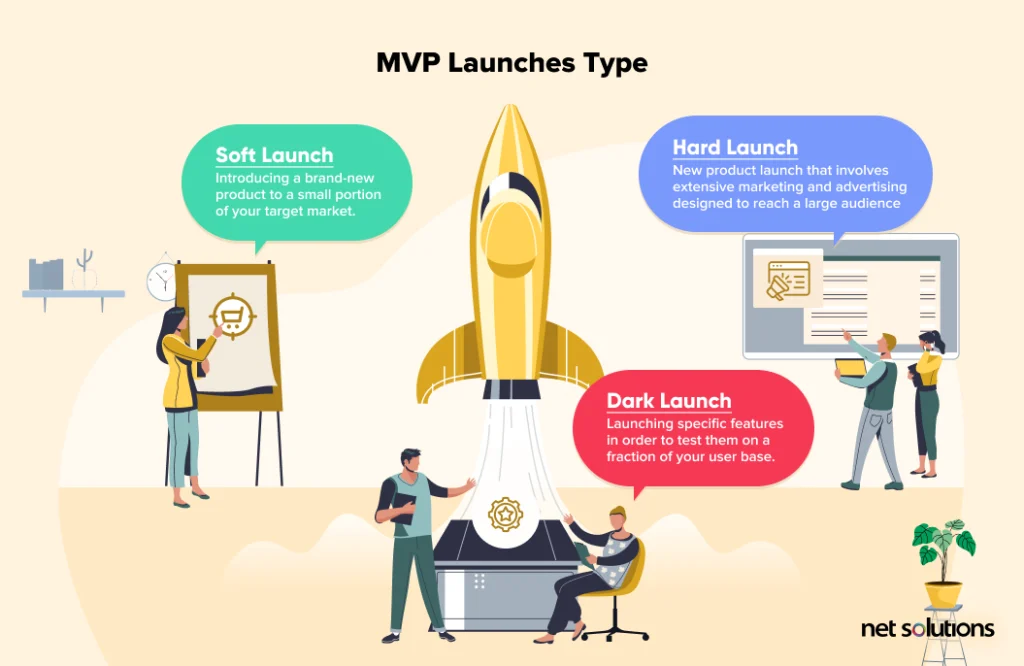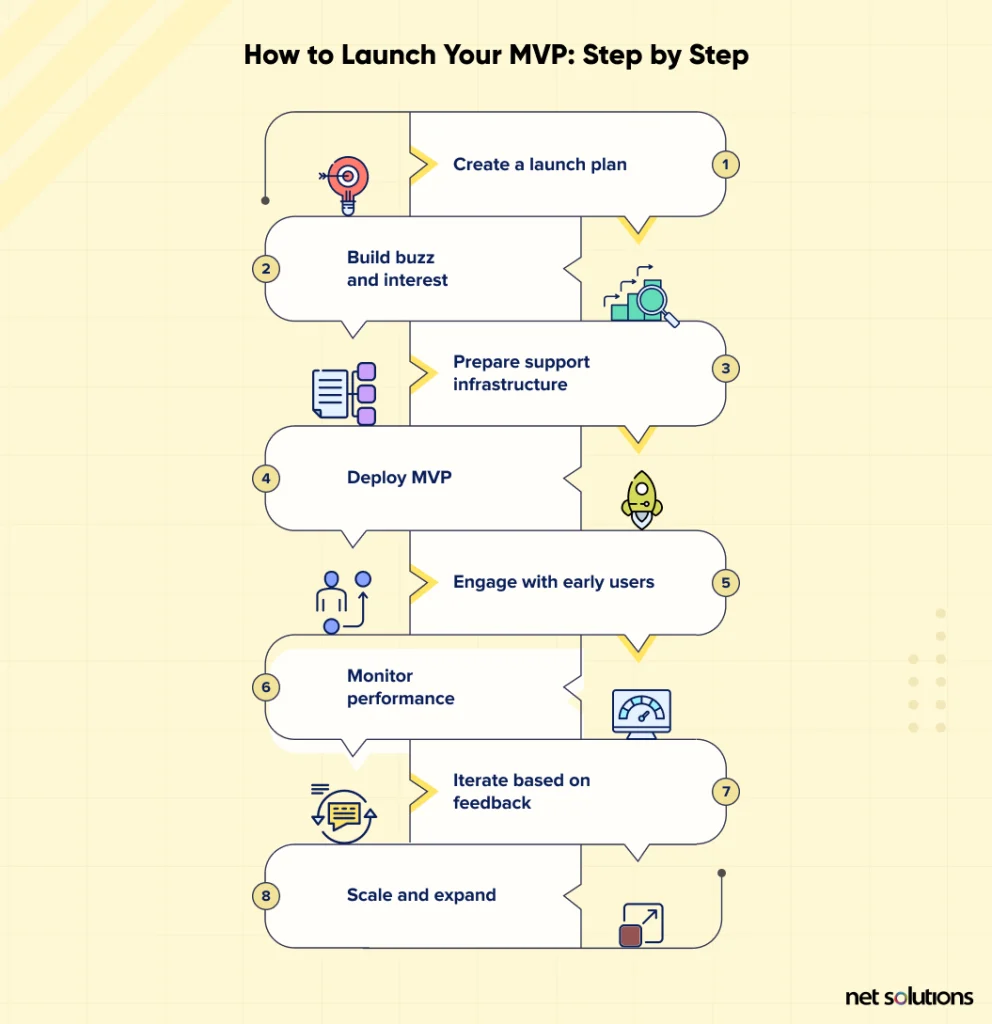Introducing a Minimum Viable Product (MVP) to the market is a great way to test its viability, gather user feedback from early adopters, and introduce features and functionality that the market loves.
We’ve written at length about how to build an MVP, from market research to design and development. In other posts, we cover MVP costs and examples of MVPs for well-known companies.
In this article, we’ll outline the steps required to successfully launch your MVP. We’ll also cover everything that follows a successful launch, including monitoring, iteration, scaling, and more.
MVP Launch Types
Before diving into the steps required to launch an MVP, it’s important to understand the different types of product launches that startups and enterprises use when releasing a new product (or product version).

Three common product launch types are the soft launch, the hard launch, and the dark launch. Each serves its own purpose and may be used by different teams under specific circumstances. However, in most cases, only one of these strategies (the soft launch) is ideal for an MVP.
Soft launch
A soft launch involves introducing a brand-new product to a small portion of your target market, making it the ideal approach for an initial MVP release.
This launch strategy avoids massive marketing campaigns and fanfare because the goal is to validate the product and get an initial round of customer feedback. You do not need or want your product tested by a huge audience.
In fact, you only need a small sample size of the market to determine product-market fit and gather feedback on the core features you’ve introduced. Plus, you only have one chance to make a first impression, so you’ll want to limit the number of people experiencing the product at that minimally viable stage.
A successful soft launch will pave the way for your eventual hard launch, assuming the market validates your business idea and value proposition.
Hard launch
A hard launch is a new product launch that involves extensive marketing and advertising designed to reach a large audience, and it’s usually reserved for fully developed digital products that have already gone through the MVP stage.
The product you release for your hard launch will have addressed a range of customer pain points, based on everything you’ve learned from active users. In other words, you know your product idea is solid, and you’ve integrated new features driven by real-world feedback (not just user testing).
The hard launch may involve social media campaigns (e.g., Instagram, LinkedIn, Facebook), press releases, paid advertisements, and other efforts to get the word out.
Dark launch
A dark launch refers to launching specific features in order to test them on a fraction of your user base. If you have a statistically significant sample (i.e., a sample size large enough that your results are unlikely to be the product of random chance), then you can gauge whether it’s worth implementing the change to the entire product
Let’s say, for example, Uber wanted to introduce a feature called “Let’s Chat” that would match chatty drivers with talkative passengers. Rather than introducing on every app, they could sample the feature to a small percentage of users in different markets to see how they respond.
If nobody uses the new feature, they can scrap it. However, if drivers and riders like it, they could expand it across different markets or even across the board.
Dark launching can be effective as long as you’ve got a large enough user base. If your user base is small, as is often the case during the MVP phase, it’s hard to get a statistically significant sample required to evaluate user behavior.
How to Launch Your MVP: Step by Step
While launching may seem simple compared to coding and design, it’s a key aspect of MVP product development. The launch phase calls for a clear strategy, and a successful MVP launch includes:
- Strategic planning
- Building interest among potential users
- Preparing a support infrastructure
- Systematic deployment
- A plan to engage early users
- Thorough performance monitoring
- Iteration based on feedback
- Building a roadmap to scale and expand the product
We’ll cover each of these eight steps to help ensure a successful product launch. Check out another post for our comprehensive MVP checklist.

- Create a launch plan
Phase: Pre-launch
The first step in your MVP launch is to plan the launch itself, carefully outlining key elements that will increase your odds of connecting with the market.
By the time you’re ready to launch, you’ll have long since identified your target audience. After all, you (hopefully) built the product with them in mind. The launch plan is all about understanding your launch goals, determining how to reach the target audience, and coming up with systems to support early users and harness their feedback.
Use the following checklist to create your launch plan, making sure your plan includes:
- Clearly stated launch goals and objectives
- Core features you want to test
- Promotion strategy (including distribution channels)
- Messaging you’ll use to attract your first round of users
- Onboarding (if necessary) and support protocols
Your launch plan will inform your strategy at every other step in your MVP launch process.
- Build buzz and interest
Phase: Pre-launch
When launching an MVP, a marketing strategy might not be the first thing that comes to mind, especially when you’re doing a soft launch. However, it would be a mistake to think that a soft launch doesn’t involve promotion of any kind. How else would you get that first set of users?
There are various ways to build buzz and interest around an MVP launch. You can use platforms like Reddit and Product Hunt to gather interest in the product and find both beta testers and early adopters. Just be sure that any beta testers know they’re beta-testing an early version that’s not even at the MVP stage, that way you can manage expectations.
You can also build buzz through paid ads, social media posts, blog posts, newsletters, email campaigns, and press releases.
- Prepare support infrastructure
Customer support is key to a successful launch, even if that only consists of a form your website used to submit questions and offer a quick response. Your support infrastructure can consist of:
- An established help desk phone number to answer live calls
- An email, form, or chat window on the website to receive questions
- Community forums
- A Frequently Asked Questions (FAQ) page
- AI chatbots
Early users may have all kinds of questions you didn’t anticipate while building the product, and it’s vital to clarify any confusion that arises.
- Deploy MVP
Phase: Launch day
How will your first round of users access your MVP software? You have a number of options when it comes to deploying your MVP, depending on the kind of software you’ve created (e.g., smartphone app, desktop-based web app).
Potential deployment channels include:
- Online platforms and marketplaces
- Direct download or access through a website or landing page
- Google Play Store (for Android apps)
- Apple Store (for iOS apps)
You can also partner with other organizations and distribute your app through their website or marketing channels, if appropriate.
- Engage with early users
Phase: Launch day
User engagement is key to a successful MVP launch for a variety of reasons.
First, engaged users give better feedback. Second, excited users will spread the word about your product. Finally, this initial, enthusiastic set of customers will form your core user base, and they’ll stick with you for the long haul if you treat them well and respond to their needs.
A strong user engagement strategy includes:
- Clear communications through email and other channels
- Easy opportunities to give feedback at every step
- Providing acknowledgment and appreciation for early user feedback
Tools like Hotjar and CrazyEgg can help you gather and evaluate user feedback and behavior. Visit our post covering great MVP tools for an in-depth exploration of different types of MVP-related software products and platforms.
- Monitor performance
Phase: Launch day and post-launch
Gathering feedback isn’t something reserved for the initial phase of the MVP rollout. In order to build a truly amazing product that serves your customers, you’ll want to continually monitor performance and gather feedback.
Set Key Performance Indicators (KPIs) to identify how your Minimum Viable Product is performing and any problem areas you’ll need to address. Some KPIs worth tracking include:
- Active users and growth
- Session duration
- Conversion rates (when offering paid plans)
- User retention
- Customer Satisfaction scores (CSAT)
- Net Promoter Score (NPS)
You’ll also want to monitor your app’s performance, including error rates, page load times, bugs, etc.
- Iterate based on feedback
Phase: Post-launch
Continuous iteration is at the heart of MVP development, which is why Agile and MVP development work so well together. From the very beginning, design and development teams shape their products based on user research, and they iterate based on input from key stakeholders and additional user tests.
Iteration can involve everything from small tweaks to existing features to brand new feature sets—or even pivoting to an entirely new product!
Many famous software companies started off with an entirely different focus, such as Instagram (originally a check-in app like Foursquare) and Twitter (a music streaming app that found its internal posting platform to be far more promising).
There’s also the fictional startup Pied Piper, which pivoted from music streaming to data compression—fans of the HBO show Silicon Valley will get the reference.
Of course, not all iterations are dramatic or exciting. Most simply involve bug fixes and performance optimization, which underscores the value of continuous monitoring.
- Scale and expand
Phase: Post-launch
Once you’ve validated your idea and begun to build a strong user base, it’s time to identify any features you want to add or modify and to polish your UI and UX design. This will make it ready for prime time, as you work to reach new customers.
Expansion involves developing a clear business strategy, which includes pricing, promotion, and possibly identifying additional distribution channels.
You’ll continue to gather feedback and add new features to remain competitive and attract new users. Iteration is a never-ending process because the competition will work tirelessly to grab a piece of your pie.
Common Mistakes to Avoid When Launching an MVP
Launching an MVP can come with its fair share of pitfalls, especially since no MVP launch is identical. It requires a fair bit of improvising and regular meetings to ensure that everyone is sticking to the overarching strategy.
Three common mistakes teams make while launching an MVP include underpromoting the MVP, ignoring user feedback, and premature scaling.
Underpromoting the MVP
While you don’t want to overpromote an MVP during a soft launch (which we discussed above), underpromoting can be an issue as well. It’s important to engage in focused promotions and capture enough early adopters to get sufficient feedback.
Working with a user base that is too small means you’ll struggle to get a large enough feedback sample. It’s like evaluating an Amazon product that has 5 stars but only 3 reviews.
A great way to get a strong user base from the beginning is to encourage people to share the signup page with friends. If you’re worried about it becoming too large, you can always make the MVP invite-only. That’s what Uber did with their initial MVP launch that targeted only San Francisco and New York City.
Ignoring user feedback
This one may sound crazy since the whole purpose behind an MVP is to solicit user feedback, but entrepreneurs have an emotional attachment to their vision, and occasionally that clouds their judgment. Passion is great, but you can’t let it interfere with a decision to drop a beloved feature or pivot entirely on your business idea if the market demands it.
Now, that doesn’t mean the user is always right. In fact, you’ll get all sorts of feedback that you won’t use. You’ll reject some of it because it doesn’t make sense. Other suggestions represent too much risk with too little reward. Many more will amount to great ideas, but you’ll decide they’re a lower priority than other ideas.
In other words, you’ll reject a lot of user feedback along the way, but you should never ignore any of it. Listen with an open mind because, in that sea of strong critiques and strange musings, there will be a handful of ideas that will show you the path to success.
Premature scaling
It can be exciting when you get that initial wave of positive feedback, but scaling too quickly can sink the entire endeavor.
Take your time validating your product idea and prioritizing features for future releases. Otherwise, you’ll end up wasting valuable time and resources on the wrong feature set.
Need a Partner to Help Develop Your MVP?
Net Solutions has developed countless MVPs for startups and large enterprises alike. Over the past 24 years, we’ve developed software for the Harvard Business Review, IMG, Euro Car Parts, Xerox
Net Solution’s MVP development services include every phase of the process: Business analysis, user research, project management, UX and UI design, development, QA testing, iteration, and scaling. We can spearhead your entire MVP project or a team to support you in any phase where you need our help.
Talk with one of our experts today and we can bring your vision to life.
SHARE THIS POST
Table of Contents
Related Resources
- What Is an MVP App? A Guide to Building Successful Products
- A Deep Dive Into 7 Minimum Viable Product Benefits
- A Step-by-Step Guide to Build a Minimum Viable Product (MVP)
- 19-Step Minimum Viable Product (MVP) Checklist [With PDF]
- How Much Does a Minimum Viable Product (MVP) Cost? Here’s the Answer
- 10 Top MVP Development Companies [Great for Startups]
- 10 Minimum Viable Product (MVP) Examples You Should Know
- The Ultimate Guide to Developing an MVP in Agile: What, How, and Why
- How to Prioritize Features for Your Minimum Viable Product (MVP)
- How to Test an MVP: 15 Proven Strategies that Work
- 20 Great MVP Tools to Help You Create & Launch Your Product
- 11 different Types of MVPs to Kickstart Your Software Project
- How to Nail MVP Design with UX Design Principles that Work
- MVP Website: Benefits, Best Practices, How to Build & More

